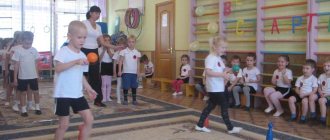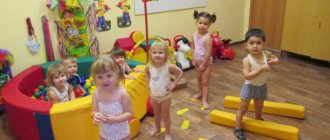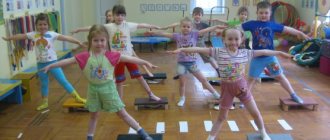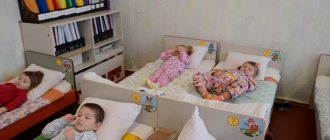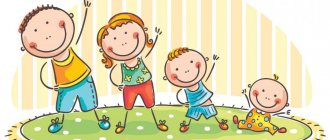Complex of morning exercises for different age groups.
Municipal state preschool educational institution
Yushinsky kindergarten
"Morning exercise complexes"
in a mixed age group
Completed by: teacher Murzova L.L.
Morning exercise complex No. 1
A cord is laid out along the hall, which divides it into two parts - “paths”. The starting line is also marked with a cord. On the opposite side of the hall, at the finish line, balls are placed according to the number of children. Younger and older children stand in a line at the starting line, with a teacher between them. At his command, the children walk towards the balls, take them and turn around. On command, children with a ball in their hands return to the starting line. Then, on command, the children roll the ball forward, energetically pushing it away from themselves in a straight direction, and catch up with it. Return to the starting line. Walking and running are repeated 2-3 times.
General developmental exercises with a ball.
- I.p. – feet shoulder-width apart, ball in both hands below. Raise the ball up, rise on your toes and stretch; return to I.P. (5-6 times)
- I.p. – feet hip-width apart, ball in bent arms in front of you. sit down; bring the ball forward; i.p.; squat hands with the ball up; I.P. (4-5 times)
- I.p. – kneeling position, ball in both hands on the floor. Rolling the ball around the body, moving it with your hands, turning to the right and left (3 times each)
- I.p. – legs slightly apart, arms at random, ball on the floor. Jumping on two legs around the ball in both directions (2-3 times).
- Walking in a column one at a time with a ball in their hands.
Morning exercise complex No. 2
Walking in a column one at a time, with the older children in front, and the younger children at a distance of about 2 m from them. Children can catch up with their elders while walking, and then again fall behind a little, as if to “stretch” (later children will learn to keep their distance). While walking, the teacher gives tasks (there may be several of them). For example, at the “Frog” signal, children stop, squat down, then get up and continue walking.
Running in all directions throughout the hall. The teacher makes sure that the children do not touch each other.
ORU.
- I.p. – feet shoulder-width apart, hands on waist. Raise the right 9left () leg, bend at the knee, arms to the sides, lower the leg, return to the i.p. (5-6 times)
- I.p. – feet shoulder-width apart, hands on waist. Tilt to the right (left) with a slow movement. Return to i.p. (3-4 times).
- I.p. – lying on your stomach, arms extended forward. Bend over, raising your torso, stretch your arms forward and slightly to the sides. Return to i.p. (5-6 times).
- I.p. – lying on your back, arms straight behind your head. Raise your legs forward - up, touch your knees with your hands. Lower your legs, return to IP. (5-6 times).
- Game task “We stomp our feet.”
Children stand in two semicircles (in subgroups) on opposite sides of the hall. The teacher stands between them - in the center of the circle. Together with the teacher, the children recite a poem and perform the appropriate actions:
We stomp our feet
We clap our hands
We shake our heads.
We raise our hands
We give up
And we run around.
After saying the last line, the children, at the teacher’s signal, turn right and run in a circle. After some time, they stop at a signal and the game is repeated. Finally, walk at a moderate pace.
Morning exercise complex No. 3
Game task “Migration of birds”. Along the hall there is a cord - a “dividing strip”. Children stand on both sides of the strip on the starting line in two lines at a distance of 1-2 steps from each other. The teacher invites the “birds” to learn to fly a little.
Children raise their arms to the sides, open by stepping (in each subgroup from the center), then lower their arms.
At the signal “the birds have flown,” the children, spreading their arms like wings, run in a straight direction to the “clearing” (beyond the conventional line). They turn around and come back. The dashes are repeated 3-4 times. Each subgroup runs at its own pace.
Open switchgear with cubes.
- I.p. – legs at the width of the foot, cubes in both hands below. Lift the cubes up through the sides, rise onto your toes; lower your hands down, return to IP. (6 times).
- I.p. – feet shoulder-width apart, cubes behind your back. Lean forward, touch your legs with cubes, or straighten up, return to standing position. (5-6 times).
- I.p. – legs at the width of the foot, cubes in the hands at the shoulders. Sit down, bring the cubes forward, arms straight. Get up, return to standing position. (5-6 times).
- I.p. – sitting in front of the cubes, legs crossed. Hold the cube with both hands. Turn your torso to the right (left), place the cube at the toe of your (right) leg, straighten up. Turn the body to the right (left), take the cube, straighten up, return to the i.p. (3 times).
- I.p. – standing in front of the cubes, hands on the belt. Jumping on two legs around the cubes in both directions (2-3 times).
- Walking randomly throughout the hall; walking in a column one at a time.
Morning exercise complex No. 4
Game task “Don’t touch me.” On two opposite sides of the hall, cubes (6-8 pieces) are placed in a row at a distance of 40 cm from one another. Subgroups are built in two lines - each in front of its own row of cubes. After explaining the task and showing the exercise, the children line up in columns. The teacher draws attention to the need to maintain distance when completing the task. At a signal, children walk and run between the blocks.
Outdoor switchgear with flags.
- I.p. – feet shoulder-width apart, flags in hands below. Raise the flags to the sides (arms straight). Lower the flags down (4-5 times)
- I.p. – feet shoulder-width apart, flags in hands behind your back. Flags to the sides (arms straight). Lean forward, cross the flags in front of you. Straighten the flags to the sides. Return to i.p. (4-5 times)
- I.p. – feet shoulder-width apart, flags in hands below. Turn your torso to the right (left), arms to the sides, wave the flags. Straighten up, return to standing position. (3 times).
- I.p. – feet hip-width apart, flags at the shoulders. Sit down and bring the flags forward. Return to i.p. (4-5 times)
- Walk with flags in your hands (both flags in one hand), waving above your head, about half a circle. Then, as they move, the children put flags in the box.
Morning exercise complex No. 5
Walking in a column one at a time: the older children are in front of them - the little ones. At the teacher’s signal “Heron!” children stop and raise their leg bent at the knee and their hands on their waist. Normal walking and repeating the task (raise the other leg. Switch to running at a moderate pace. At the signal “Butterflies!” the children wave their arms like wings. Normal walking.
ORU.
- I.p. – feet hip-width apart, hands on the waist. Hands to the sides, hands behind the head, hands to the sides. I.p. (5-6 times)
- I.p. - Same. Hands to the side; sit down, clap your hands in front of you; stand up, arms to the sides, return to standing position. (4-5 times).
- I.p. – feet shoulder-width apart, hands on waist. Hands to the side; lean forward, touch the floor with your hands. Straighten up, arms to the sides; return to IP (4-5 times)
- I.p. - stand on your knees, hands on your belt. Turn your torso to the right (left), touch your right (left) hand to your leg. Straighten up, return to standing position. (3 times).
- I.p. – legs slightly apart, arms at random. Jumping on two legs in place with a circle turn in both directions for a count of 1-8 (3-4 times).
Morning exercise complex No. 6
Walking in a column one at a time; walking and running at a moderate pace between chairs (according to the number of children), placed in a checkerboard pattern. The teacher sets the pace of walking and running using a tambourine. Walking and running exercises alternate.
Outdoor switchgear on chairs
- I.p. – sitting on a chair, legs apart, hands on the waist. Hands to the sides, behind the head, to the sides, return to IP. (4-5 times).
- I.p. – sitting on a chair, legs apart, hands on the waist. Hands to the side; lean to the right (left), touch the fingers of your right (left) hand to the floor. Straighten up, arms to the sides, return to standing position. (3 times).
- I.p. – sitting on a chair, legs together, hands resting on the edges of the seat. Raise your legs straight; lower, return to i.p. (5 times).
- I.p. – standing behind a chair, legs slightly apart, hands holding the back of the chair. Slowly sit down, leaning your hands on the back of the chair, squatting and spreading your knees to the sides. Return to i.p. (5-6 times)
- I.p. – standing behind the chairs, arms freely. Jumping around the chair in both directions (3-4 times).
- Game task “Get to your places!” At the teacher's signal, children run in all directions. At the signal “Get to your places!” Each player occupies any free chair. When repeating the game task, one chair runs away. The one who failed to take a place lost. It is carried out 2-3 times.
- Walking in a column, one at a time, around the chairs.
Morning exercise complex No. 7
Walking in a column one at a time, stopping at the teacher’s signal, running in a column one at a time.
outdoor switchgear
.
- I.p. – legs hip-width apart, arms along the body. Raise your arms to the sides, clench your hands into a fist. Return to i.p. (5-6 times).
- I.p. – legs slightly apart, hands behind your back. Sit down, bring your arms forward, clenching your hands into a fist. Get up, return to standing position. (5-6 times).
- I.p. – feet shoulder-width apart, arms along the body. Hands behind your head, tilt to the right (left) (3 times).
- I.p. – sitting, legs straight together, arms supported behind you. Raise your legs forward and up, bend your knees, straighten, return to standing position. (4-5 times)
- I.p. – lying on your back, legs straight, arms along the body. Bend your knees, clasping your arms. Straighten up. Return to i.p. (5-6 times).
- Game "Frogs - jumping". Along the hall there is a cord - a “dividing strip”. Children - “frogs” stand in ranks on the starting line (distance 1 meter). The teacher says the text:
Here are the frogs jumping along the path,
Stretching out my legs,
Kva-kva, kva-kva-kva, they jump along the path,
Stretching out your legs.
In accordance with the rhythm of the poem, children perform jumps on two legs, moving forward to the opposite side of the hall. Having reached the wall, they turn around. After a pause, the game task is repeated.
Morning exercise complex No. 8
Walking and running between objects (cubes, pins, etc.) at the command of the teacher. Each subgroup performs the exercise in its own part of the hall, separated from the other by a cord.
ORU with the ball.
- I.p. – feet shoulder-width apart, ball in bent arms near the chest. Straightening your arms, lift the ball up, stretch, and rise on your toes. Lower the ball, return to IP (5-6 times).
- I.p. - Same. Lift the ball up, lean towards your right foot, touch the floor between your right and left feet, lean towards your left foot. Return to i.p. (5-6 times).
- I.p. – sitting on your knees, the ball in front of you. Roll the ball around your body to the right, moving your hands; the same to the left (2-3 times). Each subgroup performs the exercise at its own pace.
- I.p. – lying on your back, legs straight, ball in both hands behind your head. raise your straight legs forward and up, touch your knees with the ball; return to IP (5-6 times).
- I.p. – feet hip-width apart, ball in bent arms near the chest. Jumping on two in place for a count of 1-7, for a count of 8 – jump to the right. Jump to the count of 1-7 on the spot, to the count of 8 - return to the jump. The same with jumping to the left (2-3 times).
- Walking in a column one at a time with a ball in their hands.
Morning exercise complex No. 9
Walking and running at the teacher’s signal in a column, one at a time, between objects (5-6 pieces), placed at a distance of 30 - 40 cm on opposite sides of the hall. The main attention is paid to ensuring that children do not touch objects, and at the end of the task, walk around them from the outside.
ORU.
- I.p. – legs feet-width apart, cube in right hand. Hands to the sides, up: pass the cube to the left hand; hands to the side; lower. The same when passing the cube to the right hand (4-5 times).
- I.p. - Same. Squatting, pass the cube to your left hand; stand up. The same when passing the cube to the right hand (4-5 times).
- I.p. – feet shoulder-width apart, cube in right hand. Bend over and place the cube on the floor between your legs; straighten up, put your hands behind your back. Bend over, take the cube with your left hand, straighten up, put your hands behind your back. Bend over, take the cube with your left hand, straighten up, bend over, put the cube on the floor with your left hand, etc.
- I.p. – stand on your knees, cube in your right hand. Turn your torso to the right, place the cube on the floor; straighten up, hands on your waist. Turn your torso to the right, take a cube, transfer it to your left hand. The same to the left (3 times).
- I.p. – standing in front of the cube, legs slightly apart, hands on the waist. Jumping on two legs around the cube in both directions with a short pause between turns (3-4 times).
- Walking in a column one at a time with a cube in hand.
Morning exercise complex No. 10
Walking and running at the teacher’s signal in a column, one at a time, between objects (5-6 pieces), placed at a distance of 30 - 40 cm on opposite sides of the hall. The main attention is paid to ensuring that children do not touch objects, and at the end of the task, walk around them from the outside. ORU.
- I.p. – legs hip-width apart, arms along the body. Arms forward, to the sides, forward; return to IP (5 times).
- I.p. – feet shoulder-width apart, arms up (straight). Lean forward; swing both arms forward, backward, forward. Straighten up, return to standing position. (4-5 times).
- I.p. – feet hip-width apart, hands on the waist. Sit down, arms forward, arms to the sides. Return to i.p. (4-5 times).
- I.p. – feet shoulder-width apart, hands behind your head. Turn your torso to the right, move your right arm to the side. Straighten up and return to standing position. The same to the left (3 times).
- Jumping on two legs, moving forward between objects.
- Walking in a column one at a time.
Methodology for morning exercises for children of all age groups
Methodology for morning exercises for children of all age groups.
In the process of morning exercises, it is necessary to ensure the correct physical, mental and emotional stress. Physical activity increases gradually: having reached its highest value during jumping and running, it decreases towards the end of morning exercises. The motor density of morning exercises should be high, so minimal time is allocated for explaining and demonstrating exercises, distributing physical education equipment and changing lines. Physical activity increases by increasing the number of repetitions of each movement, the pace of their execution and reducing the interval between exercises. It also depends on the total duration of morning exercises: in the first junior group its duration is 4–5 minutes; in the second youngest - 5-6 minutes; on average - 6-8 minutes; in the eldest – 8–10 minutes; in preparatory school - 10-12 minutes.
Morning exercises use exercises familiar to children, so the mental load (on attention, memory) is almost always moderate. Physical exercise has a more beneficial effect on the body when it evokes a cheerful mood and positive emotions. And the teacher, correctly alternating exercises and giving sufficient load, creates interest in children in morning exercises. It is equally important to carry out the exercises emotionally, using various techniques and musical accompaniment. However, exercise and music should not overstimulate children because this can lead to fatigue and decreased appetite.
At the beginning of the year, children of the first junior group are not lined up before performing exercises: they walk and run in a flock, scattered. In the future, morning exercises in this group also begin with formation in a column, one at a time or in one line. Turns to the right, left, and around are more often used in older groups.
To perform general developmental exercises, young children are lined up in a circle, scattered; from the middle group they are usually rebuilt into a column of three or four. With this structure, it is easier for the teacher to monitor the quality of general developmental exercises performed by all children and to pay attention to correct posture.
At the beginning of morning exercises, walking in place is often given (regular, with high knees). This helps organize children and focus their attention.
To prevent flat feet, it is advisable to give different types of walking in the following combination at the beginning and at the end of morning exercises: normal walking, on toes, heels, and the edges of the feet. This combination is repeated 6–8 times.
It is useful to change your walking speed - from slow to fast, from fast to slow (with acceleration and deceleration).
It is necessary to ensure that children do not shuffle their feet or sway when walking, keep their heads straight, swing their arms rhythmically, and breathe through their nose. The teacher prevents mistakes with appropriate instructions, and if they do occur, corrects them without stopping walking.
When walking with high knees, imitation is used (“horses”, “herons”, “walking in deep snow”).
Running in morning exercises in younger groups is first carried out in a flock, scattered, and then in a column one at a time, both in place and with advancement in different directions.
Before general developmental exercises, running is performed at an average pace and alternates with walking. After performing general developmental exercises, running is carried out at a faster pace to train the cardiovascular and respiratory systems. The alternation of running and walking is repeated 2-3 times. The duration of running without a break gradually increases: for younger children it is 10–20 s, for middle age – 20–25 s, for older age – 25–30 s, for children 6 years old – 30–40 s (these norms can be changed depending on on the state of health, physical development, physical fitness of children). The teacher makes sure that indoors, on a playground with hard ground, children run on their toes, raising their knees higher.
Morning exercises include different types of jumps: jumping on one and two legs in place and moving in different directions (forward, backward, sideways, etc.); jumping over objects (sticks, hoops, cubes); For older children, the total number of jumps in morning exercises can be increased to 25–30. In younger groups, imitation (“bunnies”, “balls”) is used when jumping.
General developmental exercises for morning exercises are selected in the following sequence: first, exercises are given for the muscles of the arms and shoulder girdle, after which exercises that strengthen the muscles of the torso and legs are advisable.
At the end of the gymnastics, after running, alternating with jumping and walking, exercises can be performed for the shoulder girdle and arms, which help calm the body.
Exercises for large muscles (especially in older age) are combined with movements for the muscles of the neck, hands, fingers and feet. For example, when raising your arms up, it is recommended to simultaneously clench your hands into fists and unclench them.
The number of general developmental exercises and their dosage increase with the age of children, as physical development and physical fitness improve. For children of the first junior group, 3–4 exercises are recommended; for the second youngest – 4 and middle – 4–5; for the eldest – 5–6; for preparatory school – 6–8. In the first and second junior groups, the exercises are repeated 4–5 times; on average - 5-6 times; in the oldest – 6–8 times; in preparatory school - 8-10 times. In this case, exercises for the arms and shoulder girdle are repeated more times (8–10); and more difficult ones - for the abdominal muscles, back - 4-6 times.
Exercises can be performed at different paces, for example: first 2-3 times at a medium pace, then 3-4 times at a fast pace, then 2-3 times at a slow pace. This increases physical stress on the body, promotes the development of speed, and increases children’s interest in the activity.
General developmental exercises are performed from different starting positions of the body: standing, sitting, lying down (on the back, on the stomach). The starting positions of lying down and sitting are beneficial in that they relieve the pressure of body weight on the spine and fragile arch of the foot, and allow you to increase the tension of individual muscles. Therefore, during morning exercises, it is recommended to use chairs and gymnastic benches to perform exercises from starting positions while sitting. Exercises for the arms and shoulder girdle are performed by younger children from the starting position - narrow leg stand apart, and by older children - the main stand, closed stoic position.
Exercises for the trunk muscles at a younger age are carried out from the starting position: narrow leg stand apart, leg stand apart, and at an older age - leg stand apart, wide leg stand apart.
In leg exercises at a younger age, a narrow stance with legs apart is used, and at an older age, the main stance is used.
When conducting general developmental exercises with objects, you need to think through the order of their distribution and collection, and provide for the formation of the group so that the children do not interfere with each other.
At an older age, general developmental exercises without objects occupy a larger volume.
In younger groups, the teacher performs general developmental exercises with the children. In the middle group, he first names the exercise, briefly explains it (shows it if necessary), and then gives a command for the starting position and execution. When explaining, children's attention is fixed on the most difficult elements of the exercise. If errors do occur, instructions for correcting them are given during the exercise. Instructions should be aimed at clarifying the understanding of the elements of the exercise and facilitating their correct implementation. This is helped by combining counting with words denoting elements of the technique, or even replacing counting with specific words (for example, instead of “one”, the teacher says: “Squat down, back straight”).
The teacher must think about when he will use counting when repeating an exercise, and when he will replace it with words that clarify the idea of this element of technique. The appropriate alternation of counting, words (instructions) and other signals (moving the hand down - “crouched”, upward - “straightened up” in the “squat” exercise) helps children perform the movement more correctly and with great interest.
At an older age, children can do the exercise by name, but sometimes in the older group the teacher does the exercise together with the children. This reduces the reminder time and increases physical stress on the body. Following the teacher’s actions, children clarify their understanding of movement technique and try to correct mistakes. But such a joint exercise is only advisable if the teacher sees the whole group and can observe the actions of the children and their behavior (when bending to the sides, when squatting, etc.). Sometimes a child who does the exercises correctly is placed at the front of the group.
During morning exercises, the teacher carefully monitors each child and, if necessary, provides physical assistance to individual children, gives instructions, and encourages (especially younger children).
When performing general developmental exercises, imitation is used in all age groups. For younger children, the complexes are built in a plot form and based on one image (“birds”, “butterflies”, “watches”, “planes”, etc.). Instructions are given to children according to the selected image (for example, “the sparrows flew”). In the second younger group, children imitate different images in one complex. In the middle group, imitation is used only when performing some exercises, and in the older group - to perform individual elements of the exercise.
During morning exercises, the teacher makes sure that each exercise ends with a good straightening of the torso, which helps strengthen the muscles that support the straight position of the body, as well as strengthening the skill of correct posture. When performing exercises, the teacher reinforces the children's correct breathing skills.
Musical accompaniment during morning exercises helps children simultaneously start and finish the exercise in a timely manner, determines the tempo of individual elements of the movement, evokes positive emotions and creates a cheerful mood. Children learn to listen to music and coordinate movements with its character, perform exercises clearly, expressively, smoothly.
Features of the methodology for conducting morning exercises on the site. In spring and summer, as a rule, morning exercises are carried out with children of all age groups on the site. The teacher, depending on the weather, selects exercises and regulates physical activity: when the temperature drops, he increases it, changing the pace of performance; when the temperature rises, it decreases to avoid overheating of the body.
In late autumn and winter, morning exercises can be carried out on the site with children who are the most physically prepared and seasoned. Exercises are selected taking into account temperature, clothing and are performed at a more vigorous pace. Particular care must be taken to ensure that children do not get cold.
Features of the methodology for conducting morning exercises in a mixed group. If the children in the group differ sharply in age (from 2–3 to 6–7 years), then morning exercises are carried out separately with each subgroup.
If the age difference between children is small (for example, children 5 and 6 years old), then morning exercises can be done simultaneously with everyone. When changing lanes, older children help the younger ones complete the task. When walking, older children are given more complex tasks (for example, placing their hands to their shoulders).
General developmental exercises are selected so that they are accessible to both subgroups, and all children begin to perform them at the same time. Then younger children rest, and older children continue to perform the exercise several more times at a faster pace. When running and jumping are given, the dosage is increased for older children.
Options for morning exercises
Various forms of morning exercises are used:
– traditional form using general developmental exercises;
- playing out some plot: “On a walk”, “We went to the meadow”, “Sparrows”, etc.;
– gaming nature (from 3-4 outdoor games);
– using elements of rhythmic gymnastics, dance movements, round dances;
– recreational running (carried out on a site for 3-5 minutes with a gradual increase in distance, intensity, time);
– using an obstacle course (you can create different obstacle courses using a variety of modules);
– using the simplest exercise equipment (children’s expander, gymnastic roller, etc.) and complex exercise equipment (“Bicycle”, “Rowing”, “Treadmill”, “Trampoline”, etc.)
Used Books:
- Golitsina N.S., Bukharova E.E.
Physical education kaleidoscope for preschoolers. – M.: Publishing house “Scriptorium 2003”, 2006.
- Kartushina M.Yu.
Logorhythmics for kids: Scenarios for classes with children 3 – 4 years old. – M.: TC Sfera, 2005. – 144 p. (Development program.)
- Kartushina M.Yu.
Scenarios of recreational activities for children 3–4 years old. – M.: TC Sfera, 2007. – 96 p. – (Series “Together with children”).
- Penzulaeva L.I.
Health-improving gymnastics for preschool children (3 – 7 years old). – M.: Humanitarian Publishing Center VLADOS, 2003. – 128 p.
- Sochevanova E.A.
Complexes of morning exercises for children 3 – 4 years old: Methodological manual. – SPb.: “CHILDHOOD-PRESS”, 2005. – 48С.
- Kharchenko T.E.
Morning exercises in kindergarten. Exercises for children 3 – 5 years old. – M.: Mosaika-Sintez, 2008.
